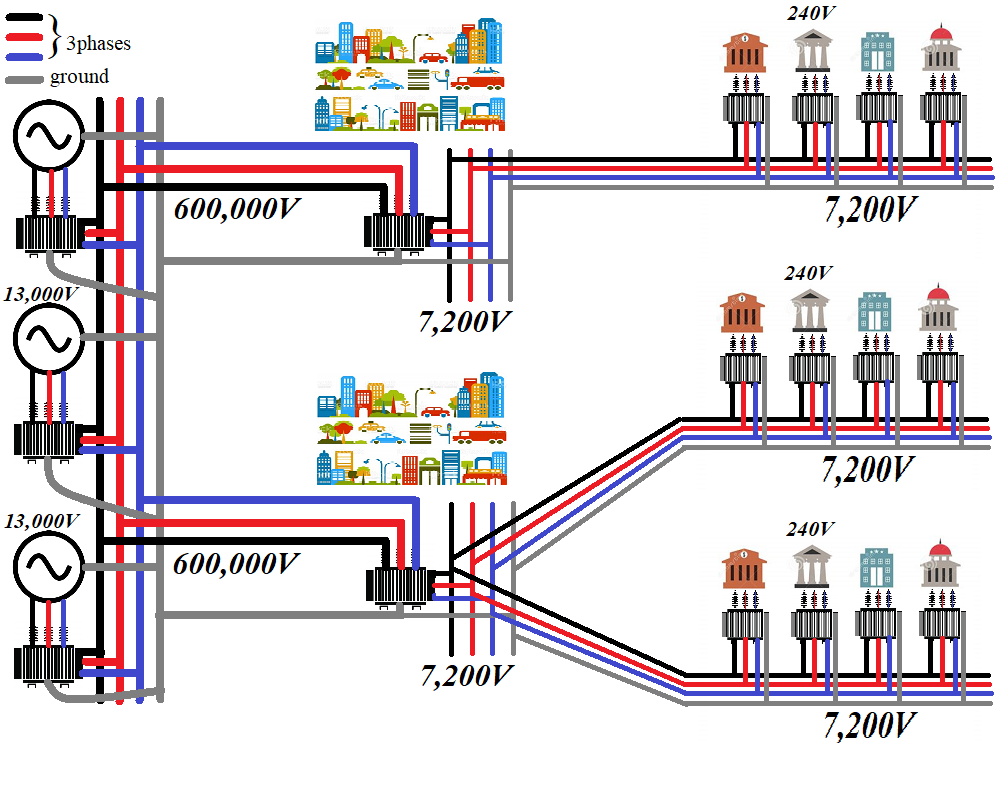Distribution to Consumers
When we described the grid in the previous lecture, we concentrated on main principles of its work - synchronization of the generators of electric energy with the grid. It might make a wrong impression that the grid is one gigantic wire that have certain voltage, frequency and phase, and all the generators must adhere to this standard, when connected to it.
The real situation is more complex.
Considering the grid covers large distances, we must maintain the high voltage in it to avoid waste of energy to heat (hundreds of thousands of volts). Most consumers, however, need relatively lower voltage (no more than a few hundred volts).
To connect each consumer to a grid through a powerful and very expensive transformer is impractical. Instead, we combine a group of geographically close consumers into it's own grid, connected at one point to a main ultra high voltage grid through a transformer that lowers the voltage, and then we connect consumers to this second level grid.
For example, the whole city can form this secondary grid with lower voltage than in the main ultra high voltage grid. Thus formed, this secondary grid can go to each street with lower voltage better suitable for consumption. And, because this grid is relatively localized, there will be no big loss of energy to distribute electricity at a lower voltage.
Making the picture even more complex, we can arrange third level grid lowering the voltage for each building in the city from street level of the secondary grid to a lower voltage building level that goes to each apartment.
Yet another complication can be introduced by connecting other generators to a grid. Since our grid now consists of many grids connected via transformers from main ultra high voltage to second level with lower voltage in the city and third level for each building, we can introduce generators into each grid, and the only requirement for this is to make sure that each generator conforms to a corresponding grid's voltage, frequency and phase.
For example, a building's management decided to put solar panels on the roof. They generate electricity for a building and, if there is excess of energy, it goes to a grid for general consumption. That, probably, is the third level grid that serves this building, it has it's own characteristics, and the output of solar panels must conform to these characteristics.
Similarly, a city decided to build a power plant working on burning the garbage. This power plant produces electricity that should go to a grid that serves the whole city, which we call the second level grid. The voltage produced by this plant is higher than the one in any building level grid but not as high as in main ultra high voltage grid that supplies the whole city.
The overall picture of distribution of electricity consists of different grids of different voltage, connected through transformers, having producers and consumers in each grid. Each consumer of electricity should have its parameters to be the same as the grid it's connected to (voltage and frequency). Each producer of electricity should be synchronized with the grid it's connected to in voltage, frequency and phase.
On the picture below we have schematically displayed the generation of electricity at 13,000V, transformers that increase the voltage to 600,000V to transmit along the long distances, transformers that decrease the voltage to 7,200V at the entrance to a city that supplies this electricity to buildings and, finally, transformers that decrease the voltage to 240V before entering buildings.
Inside the buildings this voltage is distributed to individual apartments.

In practice there are more devices participating in the grid, stabilizing the voltage, sensing the abnormal conditions, controlling different functions of the grid, protecting the grid against disastrous conditions, attacks or human errors etc.
The grid is constantly changing as new sources of energy come on line, new consumers are attached to a grid, new more efficient maintenance devices are introduced


No comments:
Post a Comment